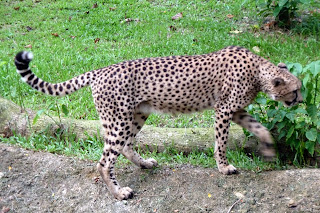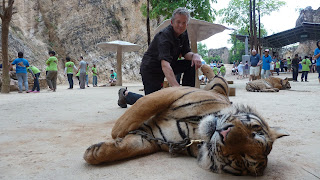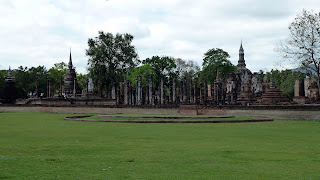The flight from Phuket to Singapore was on time and relatively short. During the taxi ride from the airport to the hotel, we rapidly appreciated what a change of scene Singapore was going to be. Everything seemed to be so well managed, well organised and well maintained. We had allowed ourselves five days here before returning to the UK. Although we had chosen a hotel with a swimming pool in order to help us relax before the challenging journey home; we never got to use it, as we found there was so much that we wanted to do. In fact, we have not managed to do it all and a return to Singapore, at some stage, is definitely on the cards. We could not have chosen a better final stop-over. In order to get about we used the very efficient MRT rail system, navigated with some considerable expertise by Peter.
Our first excursion was to the Jurong Bird Park - which was absolutely amazing and took and entire day to fully appreciate. Although the birds here are contained; they are contained in a very natural and mainly spacious environment. There were a number of walk-through aviaries of such a size that one felt one was inside a rainforest rather than an enclosure; with Macaws, Parrots and Lorys whistling past our ears. The Lorys liked to be fed on a nectar-like mixture and thought little about landing on your shoulder or wrist to collect the goodies.
There were a number of programmed events during the course of the day and during the Birds n Buddies Show in the amphitheatre Mary was chosen by the presenter to participate.
A great day indeed.
The second day saw us setting off for the Singapore Flyer: a far larger version of the London Eye (largest in the world) at over l65 metres. We decided to beat the crowds by setting off before breakfast and were, in fact, rewarded with no queue, a pod to ourselves and no-one else in sight., Singapore is a truly lovely city and amongst many interesting vistas, we were able to see part of the grand prix course and a very unusual football pitch, as you will see from the photograph. After breakfast and some chill out time, we set off for the Singapore Zoo, which was to be followed by a night-time safari. Again we hate caged animals; on the whole, the Zoo here strives to deliver a natural environment, for the most part using water to create natural barriers.
Again, we had a great time.
The third day was mostly dedicated to shopping and anyone who knows anything about Singapore, knows that shopping is the national sport and pastime. There are more serious shopping malls here, per square metre than anywhere else we have travelled and Peter hated every minute.
Our fourth and last full day was dedicated to the Botanical Gardens and the National Orchid Collection. We think that it is enough to say that it was superb.
Dear friends, tomorrow we set off on our return journey and so this very lengthy entry must be our last. The next time you hear from us will be when we are back at home.
Tuesday, 5 April 2011
Monday, 4 April 2011
Phuket & Diving
Drizzle and heavy cloud followed us on our journey to Phuket; although the weather continued to be humid. We were met at the airport and taken to sort out our dive equipment and after a fairly brief wait we were taken to our dive boat: the Colona VI where we were introduced to the crew and fellow divers. It was a fairly international affair with six Russians, three Americans, one Israeli and us two. The first two days provided us with some excellent diving; although the swell was quite strong at times, which made getting back on the boat with our dive kit on quite challenging. On the third day, however, everything changed and the weather deteriorated. After spending two days in the shelter of a bay, staying out of the way of force 8 gales and seas to match, the decision was taken by the captain to abort the trip. Obviously we were all very disappointed but agreed unanimously that safety was the first priority. Whilst spending this time sheltering we got to know each other quite well, with the help of some vodka, whisky and raki; with Mary learning some Russian and even a few words of Hebrew. The captain and his crew were first class in every way.
PS typing this on the 4th April, we saw in this morning's newspaper that the death toll to-date, in southern Thailand, from the unseasonal storms, has reached 51.
Amit's photos!
PS typing this on the 4th April, we saw in this morning's newspaper that the death toll to-date, in southern Thailand, from the unseasonal storms, has reached 51.
Amit's photos!
Sunday, 27 March 2011
Bangkok
It is probably fair to say that both of us were a little apprehensive about what we would think of Bangkok. It is notorious for being a city of sleaze and skyscrapers, pervaded by an air of thick exhaust fumes. It is, however, like most cities in that it is multifaceted and alongside the above, it is a city of ancient temples, gorgeous silks and quiet soi spaces. Bangkok sets a modern, fast and furious pace but skill maintains its links with an exotic past.
On our first day in Bangkok we went on a city tour which involved a trip down the Chao Phraya river, the Royal Palace, the Emerald Buddha and two famous wats: Wat Phra Kaeo and Wat Arun (the temple of the dawn).
On our first day in Bangkok we went on a city tour which involved a trip down the Chao Phraya river, the Royal Palace, the Emerald Buddha and two famous wats: Wat Phra Kaeo and Wat Arun (the temple of the dawn).
 |
| Original wall engravings showing key points of anatomy for Thai massage as an aid to healing at Wat Phra Kaeo |
Thursday, 24 March 2011
Sukhothai - 19th - 21st March
Once the capital city of Siam, Sukothai's old city is now laid out like an historical park, which one can cycle around and stop off to explore the various ruins as one goes. Not everyone finds these sorts of sites interesting and for that reason, we have not overloaded the blog with pictures. That said, we both found the ruins of these old temples awe-inspiring and majestic in their presence; not least, because most of them date from around the 13th century and it is clear that highly skilled craftsmen were responsible for their creation. As in all of the countries that we have visited, the Thais are mainly Buddhist. The image of Buddha is everywhere and he is most often, (not always), represented with his hands in the position as shown in the picture. This position indicates the stage of Enlightenment, so Mary is hoping that she, too, might see the light. Elephants also figure greatly in the historical consciousness of Thailand: they have carried emperors, kings and members of royalty for thousands of years; in ceremonies, in warfare and, as a means of transport. Although they continue to play their part in modern day Thailand, there are now other forms of transport available, one of which is demonstrated by the ever versatile Peter; who can, of course, ride both.
 |
| Training for LeJog |
On into Thailand - 15th to 19th March
We decided to move onto Thailand by river taking a boat up the Mekong from Luang Prabang to Houei Xai and then the ferry over to Chiang Khong in the north-east of Thailand. We managed to secure a late booking on the LuangSay cruise ( at ~ 50% list ) rather than the budget option we had intended. This was a wonderful experience despite the appalling weather; rain and cold enough to require our fleeces to be unpacked! The boat was comfortable and only 25% full; they fed us well and the scenery was magnificent.

The journey takes two days upstream and the package included an overnight in their own lodge at Pakbeng which was beautifully laid out on the bank above high water level.
In an extreme wet season, in places where the river narrows, the level can rise 20 metre or more and 5 to 10 is common elsewhere. We were in the dry season, (usually rain free), so we saw extensive sandbanks at the sides of the river. These were cultivated with catch crops such as peanuts and maize. We also saw the locals panning for gold which is washed down out of the hills.
The rain continued unabated during our brief one night stop overs in Chiang Khong and Chiang Mai but by the time we reached our next important stop over, Sukhothai, the sun had returned to keep us company.
 |

The journey takes two days upstream and the package included an overnight in their own lodge at Pakbeng which was beautifully laid out on the bank above high water level.
In an extreme wet season, in places where the river narrows, the level can rise 20 metre or more and 5 to 10 is common elsewhere. We were in the dry season, (usually rain free), so we saw extensive sandbanks at the sides of the river. These were cultivated with catch crops such as peanuts and maize. We also saw the locals panning for gold which is washed down out of the hills.
 |
| Peanut plant ! |
The rain continued unabated during our brief one night stop overs in Chiang Khong and Chiang Mai but by the time we reached our next important stop over, Sukhothai, the sun had returned to keep us company.
Monday, 21 March 2011
Luang Prabang - 9th -15th March
Luang Prabang was just a wonderful place to be and to relax after the relative bustle of Vientiane. Neither of us really feel like city lovers although we have enjoyed all the ones visited on this trip. LP is very much a tourism town although still retaining its charming and gentle manner, reinforced by an 10.30p.m. curfew on bars etc..
We flew up from Vientiane with Joe and Pip who were to stay a couple of days before returning to Thailand. We had booked ourselves into a charming guesthouse with our room opening into the garden where we took breakfast each day.
The room came with complimentary bicycles, which were to prove extremely useful during our time in this delightful little town which seemed to be packed with Temples, Wats and markets.
Our guesthouse was adjacent to a temple and the monks were to wake us by beating drums for five minutes at 5.00am on our first morning there: it marked the beginning of a two day festival (yes, it was to happen again the next day), which also included their melodious chanting at 5.00pm on both evenings. The monks only eat twice a day and their second and last meal must be eaten before 11.00am in the morning, after which, they may not eat again until the next day. To make matters even more taxing for them, they have to go out each morning to the people in the town with a covered bowl and ask for their food for that day. Well it is one way of using up the leftovers; although one would need quite a lot to feed some 200 monks every day. Many of them are quite young lads and it was refreshing to see them using up some laddish energy on the odd occasion.
The temples in the town were really quite stunning architecturally.
The town exhibits a great deal of old colonial French architecture in its shops, cafes and schools.
We flew up from Vientiane with Joe and Pip who were to stay a couple of days before returning to Thailand. We had booked ourselves into a charming guesthouse with our room opening into the garden where we took breakfast each day.
The room came with complimentary bicycles, which were to prove extremely useful during our time in this delightful little town which seemed to be packed with Temples, Wats and markets.
 |
| Before a sale |
 |
| After we bought something |
Our guesthouse was adjacent to a temple and the monks were to wake us by beating drums for five minutes at 5.00am on our first morning there: it marked the beginning of a two day festival (yes, it was to happen again the next day), which also included their melodious chanting at 5.00pm on both evenings. The monks only eat twice a day and their second and last meal must be eaten before 11.00am in the morning, after which, they may not eat again until the next day. To make matters even more taxing for them, they have to go out each morning to the people in the town with a covered bowl and ask for their food for that day. Well it is one way of using up the leftovers; although one would need quite a lot to feed some 200 monks every day. Many of them are quite young lads and it was refreshing to see them using up some laddish energy on the odd occasion.
 |
| Young monks playing in the river |
 |
| Temple at Wat Xieng Thong |
 |
| Mosaic of Tree of Life at Wat Xieng Thong |
The town exhibits a great deal of old colonial French architecture in its shops, cafes and schools.
Subscribe to:
Comments (Atom)












































